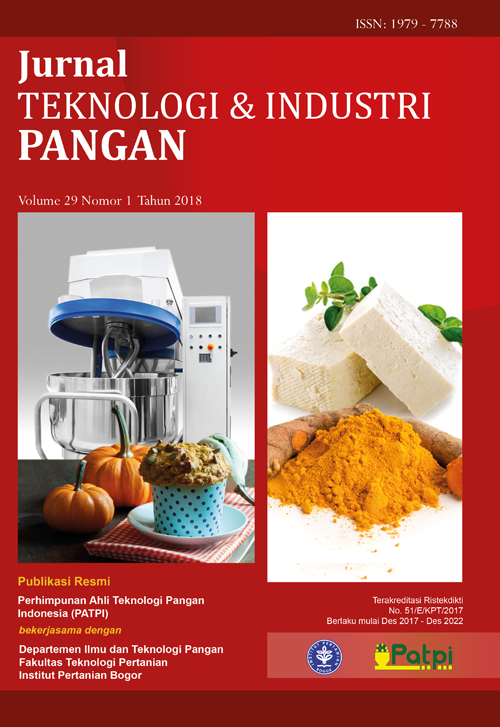FILM EDIBEL ANTIBAKTERI BERBASIS ISOLAT PROTEIN KEDELAI DENGAN EKSTRAK KUNYIT DAN NANOPARTIKEL SENG OKSIDA
Abstract
References
[ASTM] American Society for Testing and Material. 1993. Standard Test Method For Water Vapor Transmission Rate Through Plastic Film And Sheeting Using A Modulated Infrared Sensor. Annual Book of American Standard Testing Methods D1249-90. Philadelphia.
[ASTM] American Society for Testing and Material. 2002. Standard Test Method For Tensile Pro-perties Of Plastics. Standard Designation: D 882-02. Philadelphia.
Adila R, Nurmiati, Agustien A. 2013. Uji Antimikroba curcuma spp. terhadap pertumbuhan Candida albicans, Staphylococcus aureus, dan Escheri-chia coli. J Biologi Universitas Andalas 2: 1-7.
Amaliya RR, Putri WDR. 2014. Karakterisasi edibel film dari pati jagung dengan penambahan filtrat kunyit putih sebagai antibakteri. J Pangan Agroindustri 2: 45-53.
Arfat YA, Benjakul S, Prodpran T, Sumpavapol P, Songtipya P. 2015. Physico-mechanical cha-racterization and antimicrobial properties of fish protein isolate/fish skin gelatin-zinc oxide (ZnO) nanocomposite films.
Food Bioprocess Tech 9: 101-112. DOI: 10.1007/s11947-015-1602-0
Baek SK, Song KB. 2017. Development of Gracil-laria vermiculophylla extract films containing zinc oxide nanoparticles and their application in smoked salmon packaging. LWT-J Food Sci Technol 89: 269-275. DOI: 10.1016/j.lwt.2017. 10.064.
Bourbon AI, Pinheiro AC, Cerqueira MA, Rocha CMR, Avides MC, Quintas MAC, Vicente AA. 2011. Physico-chemical characterization of chi-tosan-based film incorporating bioactive com-pounds of different molecular weight. J Food Eng 106: 111-118. DOI: 10.1016/j.jfoodeng.201 1.03.024.
Danggi E. 2008. Aplikasi Kitosan Dengan Penamba-han Esensial Oil Kunyit sebagai Pengawet dan Edibel Coating Produk Tahu. [Tesis]. Bogor: Fakultas Teknologi Pertanian, Institut Perta-nian.
Dermawaty DE. 2015. Potential extract curcuma (Curcuma xanthorrizal, Roxb) as antibacterials. J Majority 4: 5-11.
Dewi PJN, Hartiati A, Mulyani S. 2016. pengaruh umur panen dan tingkat maserasi terhadap kandungan kurkumin dan aktivitas antioksidan ekstrak kunyit (Curcuma domestica Val.). J Rekayasa dan Manajemen Agroindustri 4: 101-111.
Dhivya RJ, Ranjani J, Rajendhran M, Rajasekaran J, Annaraj. 2015. Ph responsive curcumin/ZnO nanocomposite for drug delivery. Adv Mater Lett 6: 505-512. DOI: 10.5185/amlett.2015.57 66.
Kalaycioglu Z, Torlak E, Evingur GA, Ozen I, Erim B. 2017. Antimicrobial and physical properties of chitosan films incorporated with turmeric ex-tract. Int J Biol Macromol 101: 882-888. DOI: 10. 1016/j.ijbiomac.2017.03.174.
Kanmani P, Rhim JW. 2014. Properties and charac-terization of bionanocomposite films prepared with various biopolymers and ZnO nanopar-ticles. Carbohyd Polym 106: 190–199. DOI: 10. 1016/j.carbpol.2014.02.007.
Kavas N, Kavas G. 2017. Use of turmeric (Curcuma longa L.) essential oil added to an egg white protein powder-based film in the storage of co-kelek cheese. J Food Chem Nanotechnol 3: 105-110. DOI: 10.17756/jfcn.2017-045.
Krochta JM, Johnston MC. 1997. Edible and Biode-gradable Polymer Films: Challenges and Op-purtunities. J Food Technol 51: 61–74.
Liu Y, Cai Y, Jiang X, Wu J, Le X. 2016. Molecular interactions, characterization and antimicrobial activity of curcumin-chitosan blend films. Food Hydrocolloids 52: 564-572. DOI: 10.1016/j.food hyd.2015.08.005.
Meindrawan B, Suyatma NE, Muchtadi TR, Iriani ES. 2016. Preparation and characterization of bionanocomposite films made from carragee-nan, beeswax and ZnO nanoparticles. Mater Sci Forum Trans Tech Publication, Switzerland 872: 157-161. DOI: 10.4028/www.scientific.net/ MSF.872.157.
Muin R, Anggraini D, Malau F. 2017. Karakteristik fisik dan antimikroba edible film dari tepung tapioka dengan penambahan gliserol dan kunyit putih. J Teknik Kimia 3: 191-198.
Nafchi AM, Alias AK, Mahmud S, Robal M. 2012. Antimicrobial rheological and physicochemical properties of sago starch film filled with nano-rods rich zinc oxide. J Food Eng 113: 511-519. DOI: 10.1016/j.jfoodeng.2012.07.017.
Nandane AS, Jain R. 2014. Study of mechanical properties of soy protein based edible film as affected by its composition and process para-meters by using RSM. J Food Sci Technol 52: 3645-3650. DOI: 10.1007/s13197-014-1417-4.
Ojagh SM, Rezaei M, Razavi SH, Hosseini SMH. 2010. Development and evaluation of a novel biodegradable film made from chitosan and cinnamon essential oil with low affinity toward water. Food Chem 122: 161-166. DOI: 10.1016/ j.foodchem.2010.02.033.
Panea B. Ripoll G, Gonzalez J, Cuello AF, Alberti P. 2014. Effect of nanocomposite packaging con-taining different proportions of ZnO and Ag on chicken breast meat quality. J Food Eng 123: 104-112. DOI: 10.1016/j.jfoodeng.2013.09.029.
Pasaraeng E, Abidjulu J, Runtuwene MRJ. 2013. Pemanfaatan rimpang kunyit (Curcuma domes-tica Val) dalam upaya mempertahankan mutu ikan layang (Decapterus sp). J MIPA Unsrat 2: 84-87.
Putri GR. 2016. Penambahan kunyit terhadap masa simpan nugget jagung. J Ilmiah Teknol Industri (SAINTI) 13: 1-9.
Rahmawati N, Sudjarwo E, Widodo E. 2014. uji aktivitas antibakteri ekstrak herbal terhadap bakteri Escherichia coli. J Ilmu-Ilmu Peternakan Universitas Brawijaya 24: 24-31.
Rita WS. 2010. Isolasi, identifikasi, dan uji aktivitas antibakteri senyawa golongan triterpenoid pada rimpang temu putih (Curcuma zedoaria (Berg.) Roscoe). J Kimia 4: 20-26.
Shon J, Choi YH. 2011. Effect of edible coatings containing soy protein isolate (SPI) on the browning and moisture content of cut fruit and vegetables. J Appl Biol Chem 54: 190-196. DOI: 10.3839/jabc.2011.032.
Silva MAD, Bierhalz ACK, Kieckbusch TG. 2015. Alginate and pectin composite films crosslinked with Ca2+ ions: effect of the plasticizer concen-tration. Carbohyd Polym 77: 736–742. DOI: 10. 1016/j.carbpol.2009.02.014.
Singh P, Nanda A. 2013. Antimicrobial and anti-fungal potential of zinc oxide nanoparticles in comparison to conventional zinc oxide particles. J Chem Pharm Res 5: 457-463.
Torabi Z, Nafchi AM. 2013. The effects of SiO2 nanoparticles on mechanical and physiccoche-mical properties of potato starch films. J Chem Health Risk 3: 33-42.
Utami R, Nurhartadi E, Putra AYT. 2013. Pengaruh penambahan minyak atsiri kunyit putih (Kaemp-feria rotunda) pada edible film pati tapioka ter-hadap aktivitas antimikroba dan sensoris. J Teknosains Pangan 2: 51-56.
Wan VCH, Kim MS, Lee SY. 2005. Water vapor per-meability and mechanical properties of soy pro-tein isolat edibel films composed of different plasticizer combinations. J Food Sci 70: 387-391. DOI: 10.1111/j.1365-2621.2005.tb11443.x.
Wardana AA. 2016. Pembuatan Pelapis Bionano-komposit dari Tapioka, Nanopartikel ZnO dan Asam Stearat serta Aplikasinya pada Mangga Terolah Minimal. [Tesis]. Bogor: Fakultas Tek-nologi Pertanian, Institut Pertanian.
Yousef JM, Danial EN. 2012. In vitro antibacterial activity and minimum inhibitory concentration of zinc oxide and nano-particle zinc oxide against pathogenic strains. J Health Sci 2: 38-42. DOI: 10.5923/j.health.20120204.04.
Yu J, Yang J, Liu B, Ma X. 2009. Preparation and characterization of glyserol pasticized-pea starch/ZnO-carboxymethyl cellulose sodium na-no-composites. Biosource Technol 100: 2832-2841. DOI: 10.1016/j.biortech.2008.12.045.

